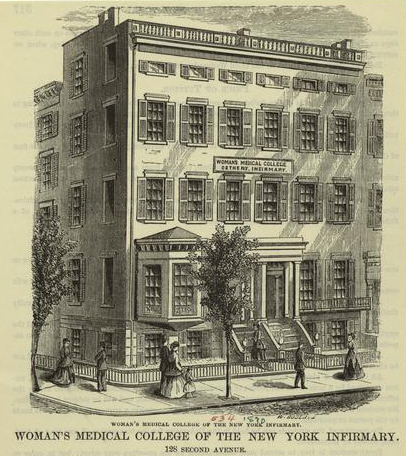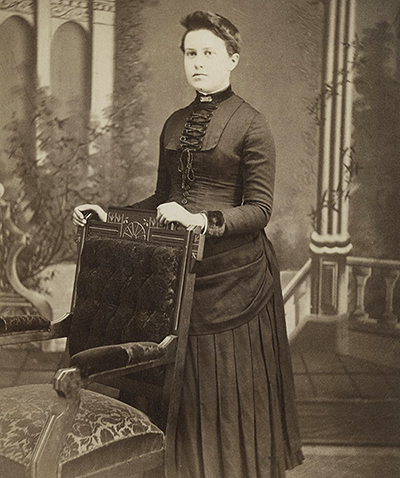Strength & Determination
From its earliest history, a significant number of Mount Allison graduates have gone on to become doctors (see Winter 2012 Record). In each graduating class, there are always a few who earn coveted spots in medical schools across the country.
Maria Louisa Angwin’s dream was the same, but her path much more difficult. Angwin, who was born in Newfoundland and later moved to Dartmouth, NS, graduated from Mount Allison with her Mistress of Liberal Arts diploma in 1869. Women would not be allowed to earn bachelor degrees for another six years, when Mount Allison awarded the first to Grace Annie Lockhart, and no Canadian medical school would admit a female student.
But Angwin was determined to obtain a medical degree.
Women were being admitted to medical school in the United States, but the training was expensive. Undaunted, Angwin studied to be a teacher, then taught school in Dartmouth for five years to raise the necessary funds.
“She was one very strong woman — strong-willed, strong-minded,” says Lois Yorke, former provincial archivist and director, Nova Scotia Archives. Much of what is known about Angwin is thanks to Yorke’s research.
 It took Angwin until 1879 — 10 years after leaving Mount Allison — before she was finally able to enroll in the Women’s Medical College of the New York Infirmary for Women and Children.
It took Angwin until 1879 — 10 years after leaving Mount Allison — before she was finally able to enroll in the Women’s Medical College of the New York Infirmary for Women and Children.
She graduated in 1882, interned at Boston’s New England Hospital for Women and Children, and completed post-graduate training in London, England.
She then returned home to open her practice.
Nova Scotia had never had a licensed female doctor and on Sept. 20, 1884, Angwin became the first. Other young women in the province had gone to the U.S. to obtain their medical degrees, but Angwin was the first to come home and seek recognition and the right to practice.
“I think she probably wanted the challenge, and she was up for it,” Yorke says. “She also identified strongly with the Methodist community in Dartmouth and Halifax. There was work and service to be done there and it was a calling for her.”
Angwin set up her medical practice in one of the poorest areas of downtown Halifax and mainly served underprivileged women and children.
She was a controversial figure. Not only was she a woman and a doctor, she advocated for women’s rights to education and to vote; was a member of the Women’s Christian Temperance Union and thus strongly opposed the use of both alcohol and cigarettes; and publicly championed physical hygiene — hardly groundbreaking today, but still suspect in the late 1800s.
In 1897 Angwin published an article in The Women’s Medical Journal defending the need for female physicians and denouncing the “senseless twaddle about ‘woman’s sphere’ and trying to keep her in paths whose sole recommendation is their sanction by long ages of custom.”
“She wasn’t afraid to speak out,” Yorke says. “She knew that to make a dent in the patriarchy, you had to be visible and vocal.”
Angwin’s medical career was unfortunately short. Just 14 years after she returned to Nova Scotia to set up practice, she died suddenly while travelling in the United States, on April 25, 1898. She was 48. Angwin is buried in the Dartmouth Common Cemetery.
 Her practice was taken over by Dr. Jane Lambert Heartz (1888), a fellow Mount Allison alumna.
Her practice was taken over by Dr. Jane Lambert Heartz (1888), a fellow Mount Allison alumna.
Despite her remarkable achievements, Angwin is not well known locally or nationally. Yorke says Angwin left no records of any kind behind and neither the Nova Scotia Archives nor the Mount Allison Archives have been able to discover any photographs of her.
“It is very difficult to find out anything about her and that’s probably why she’s disappeared under the waves, so to speak,” Yorke says.
In 2004 the Nova Scotia College of Family Physicians installed a plaque at the cemetery to mark Angwin’s gravesite as her headstone had been missing for a number of years. The organization also planted a red oak tree at the site in her honour.
A special exhibit at the Nova Scotia Museum to celebrate Canada’s 150th anniversary may also help tell Angwin’s story.
Angwin is one of 45 individuals selected as a finalist for Vanguard: 150 years of Remarkable Nova Scotians. Thirty are being featured in the museum exhibit, open until Oct. 15, 2017, while all 45, including Angwin, are included in the accompanying online exhibit and print materials.
Find out more about Maria Louisa Angwin in the Dictionary of Canadian Biography.


